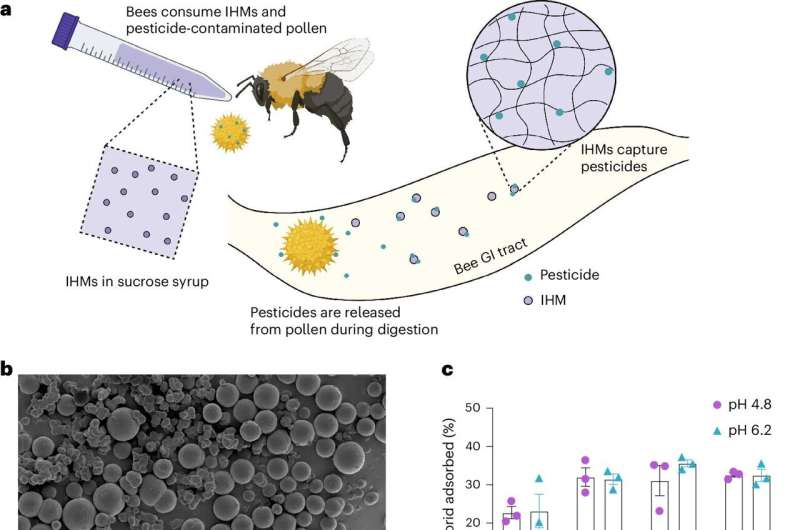This article has been reviewed according to Science X's editorial process and policies. Editors have highlighted the following attributes while ensuring the content's credibility:
fact-checked
peer-reviewed publication
trusted source
proofread
Bee antidote to deadly pesticides shows promise

Scientists may have found an antidote to pesticides that are directly and indirectly killing bees, according to a new paper published in Nature Sustainability showing promising early results in common eastern bumblebees.
The findings are critically important, as bees provide essential pollination services for close to 80% of the world's crops, but annual losses of managed U.S. honeybee hives averaged up to 44% between 2017 and 2020. Dozens of studies have documented regional and global declines of wild bees, according to the paper.
The proof-of-concept study on bumblebees describes the use of tiny ingestible hydrogel microparticles—5 microns in diameter and only visible under a microscope—that physically bind to neonicotinoids, a class of pesticides banned in Europe and still in limited use in the U.S. Once absorbed, the pesticides and microparticles pass through the bee's digestive tract and are excreted.
The study found that when the microparticles were fed to bumblebees in sugar water, they led to 30% higher survival rates in bumblebees exposed to lethal doses of neonicotinoids, and significantly lessened symptoms in bumblebees exposed to sub-lethal doses of the chemical.
The antidote has the potential to be selectively applied to other pesticides, including widely used organophosphates.
"Bees are crucial for crop pollination and agriculture, and food security, so it's important for people to take bee health seriously," said Julia Caserto, Ph.D. '24, the paper's first author and a former member of the lab of Minglin Ma, professor of biological and environmental engineering in the College of Agriculture and Life Sciences and the paper's corresponding author.
Eliminating pesticides altogether would be a good goal, but may not be fully realistic, Caserto said, "We want to try and overcome these pesticide exposures in managed bees so that we can still have sufficient crop pollination for us all to be sustainable."
Neonicotinoids get into groundwater and can be soaked up by plants, entering pollen and nectar. When bees draw nectar, they can be exposed to the pesticide, which specifically targets insect receptors. Bees also bring contaminated pollen back to hives.
In sublethal doses, neonicotinoids affect the bee's mitochondria, the cell organelle where energy is produced, and they can affect the transfer of energy in bees, inhibiting movement and flight. They also compromise bee immunity, making them more susceptible to mites and viruses.
The study showed that when bumblebees were given lethal neonicotinoid doses, bees that were fed microparticles had a 30% higher survival rate than bees that didn't receive the antidote. The researchers also found that after a sublethal dose, the microparticle treatment improved the bees' motivation to feed and led to a 44% increase in the number of bees that were able to walk across experimental channels. Similarly, using a high speed camera, the researchers found that impaired wingbeat frequency after exposure improved significantly with the treatment.
Future research directions could include testing the remedy on managed honeybees, which are smaller than bumblebees, so the pesticides may have different effects.
The treatment is not feasible for wild bees, since it would be difficult to administer the microparticles. If the antidote is eventually applied to managed bees in the field, the microparticles could be added to supplements already in use, such as pollen patties, which include pollen and other nutrients.
"The research provides not only a potential strategy to address the pesticide issues for managed bees, but also an example where interdisciplinary approaches—such as biomaterials in this case—may be taken to tackle agricultural and sustainability challenges," Ma said.
More information: Julia S. Caserto et al, Ingestible hydrogel microparticles improve bee health after pesticide exposure, Nature Sustainability (2024). DOI: 10.1038/s41893-024-01432-5
Journal information: Nature Sustainability
Provided by Cornell University





















